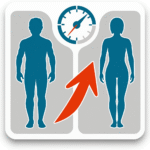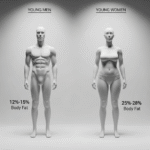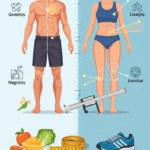Navy fat percentage calculator: Assess your body fat with ease! Ideal for military personnel and fitness enthusiasts aiming for optimal health.
U.S. Navy Body Fat Calculator
Table of Contents
Discover the importance of the U.S. Navy Body Fat Calculator for assessing and maintaining body fat percentage, essential for military readiness and overall health. This comprehensive tool aids active-duty personnel, veterans, and civilians in monitoring body composition using key measurements like height. waist, neck, and hip circumferences. Understand the calculation process and interpretations for effective fitness management. Explore tips for achieving and maintaining healthy body fat levels, debunk common myths, and learn how professional guidance can enhance your fitness journey Stay informed about body fat monitoring to promote a culture of health and well-being.
Introduction to the U.S. Navy Body Fat Calculator
The U.S. Navy Body Fat Calculator serves as a valuable tool for individuals, particularly those in the military, to assess and maintain their body fat percentage. Understanding the body fat percentage is crucial not only for meeting military standards but also for promoting overall health and fitness. The calculator is specifically designed to help personnel determine whether they fall within the Navy’s acceptable body fat limits, which are integral to the physical readiness program.
Maintaining an optimal body fat percentage is essential for various reasons. For military personnel, the ability to perform physically demanding tasks effectively hinges on their physical fitness levels. Excess body fat can negatively impact performance, endurance, and agility, making it essential for service members to monitor their body composition regularly. The U.S. Navy Body Fat Calculator contributes to this monitoring process by providing a straightforward way to determine body fat based on height and neck measurements, which are used alongside waist and hip measurements where applicable.
Beyond military applications, the body fat calculator can also benefit civilians who are interested in assessing their fitness levels. By understanding and managing their body fat, individuals can make informed decisions regarding their nutrition and exercise routines, ultimately leading to improved health outcomes. The Navy’s focus on body fat percentage highlights a broader recognition of the importance of body composition in not just military effectiveness but general well-being.
In summary, the U.S. Navy Body Fat Calculator plays a pivotal role in both military readiness and personal health maintenance, making it a significant element of physical assessment protocols. Regular use of this calculator aids individuals in staying within healthy body fat limits, thereby promoting a culture of fitness and responsibility both within and beyond military settings.
Who Should Use the Calculator?
The U.S. Navy Body Fat Calculator serves as a vital tool for various individuals seeking to understand their body fat percentage accurately. Primarily, active-duty military personnel significantly benefit from utilizing this calculator, as maintaining an acceptable body fat percentage is often essential for meeting military standards. In many branches of the military, including the Navy, body composition directly influences promotions, deployments, and overall career progression. Therefore, regular evaluation through this calculator can help service members stay within the required limits and maintain their operational readiness.
Veterans also stand to gain from the use of the body fat calculator. For those transitioning from military service to civilian life, understanding body composition can be a pivotal step in maintaining fitness and health. Veterans often continue to value physical fitness, and employing the U.S. Navy Body Fat Calculator can help them stay motivated and aware of their health metrics. It serves as a benchmark to track changes over time as they adapt to a new lifestyle away from the rigorous training of military life.
Fitness enthusiasts and individuals engaged in personal training can also leverage the U.S. Navy Body Fat Calculator as part of their overall health regimen. Body fat measurement is crucial for assessing progress toward fitness goals, whether for weight loss, muscle gain, or general health improvement. By regularly measuring body fat percentage, fitness-minded individuals can tailor their workout or nutrition programs more effectively. Thus, whether one is in the military, a veteran, or an individual committed to a healthy lifestyle, the U.S. Navy Body Fat Calculator provides an accessible and effective method to help track and manage body composition.

Key Measurements Required: A Breakdown
To accurately utilize the U.S. Navy Body Fat Calculator, precise measurements of various physical attributes are required. Understanding these measurements is essential for obtaining an accurate body fat percentage calculation, which in turn helps individuals assess their health and fitness levels.
The first measurement needed is gender, as the body fat calculation formulas differ for men and women. This fundamental distinction is based on biological differences in body composition and fat distribution. Secondly, height plays a crucial role. Individuals must measure their height in inches while standing straight and without shoes. This information helps to contextualize the other measurements in relation to overall physique.
Next, the neck circumference is measured. For this measurement, individuals should use a flexible tape measure around the neck, just below the Adam’s apple, ensuring it is snug but not tight. This is essential, as neck circumference helps indicate muscle mass compared to fat mass.
Another critical measurement is the waist circumference, which is taken at the narrowest part of the abdomen, typically located just above the belly button. This measurement is vital because it provides insight into potential health risks associated with excess abdominal fat.
Finally, hip circumference is necessary for those being assessed, particularly women. This measurement is taken around the fullest part of the hips and is essential for obtaining an accurate body fat percentage as it reflects the distribution of body fat below the waist.
All these measurements—gender, height, neck, waist, and hip circumferences—are essential components for the U.S. Navy Body Fat Calculator. Together, they provide a comprehensive view of an individual’s body composition, aiding in more effective health and fitness evaluations.
Understanding the Calculation Process
The U.S. Navy Body Fat Calculator is a tool designed to estimate an individual’s body fat percentage based on specific physical measurements. Both males and females have distinct formulas within the calculator, reflecting physiological differences. The calculations, which are rooted in anthropometric data, use variables such as height, neck circumference, waist circumference, and hip circumference (for females). Understanding this process is essential for those seeking to manage their body composition effectively.
For males, the formula utilized in the U.S. Navy Body Fat Calculator is as follows: Body Fat Percentage = 86.01 x log10(Waist – Neck) – 70.041 x log10(Height) + 36.76. In this equation, the waist measurement is subtracted from the neck measurement, reflecting the area where body fat is typically stored. Height is included to adjust the result based on overall body size. This calculation helps provide an estimate that aligns with average body fat norms for men.
Conversely, females are calculated using a different formula: Body Fat Percentage = 163.205 x log10(Waist + Hip – Neck) – 97.684 x log10(Height) – 78.387. Here, the methodology reflects the role of hip circumference, as women generally have a different fat distribution pattern compared to men. This inclusion aims to ensure accuracy in determining body fat percentage for women, reaching a more personalized assessment.
Both calculations involve the logarithmic transformation of the input measurements, which serves to stabilize variance and provide more reliable estimates of body fat. The U.S. Navy Body Fat Calculator thus emphasizes the importance of precise measurements to yield the most accurate results. This tool serves as a valuable resource for individuals looking to monitor their health and fitness objectives, considering that understanding body fat percentage is crucial for overall well-being.
Interpreting Your Results
Understanding the results obtained from the U.S. Navy Body Fat Calculator is essential for assessing your physical health and readiness. The calculator utilizes specific measurements—namely waist circumference, neck circumference, and height—to estimate body fat percentage. The outcomes of this assessment are categorized into defined ranges for both male and female personnel, which provide insight into health and fitness levels.
For males, the Navy categorizes body fat percentages as follows: below 18% is considered “excellent,” 18% to 22% is “acceptable,” while values exceeding 22% are categorized as “overweight” or “obese.” In females, a body fat percentage under 26% is deemed “excellent,” while 26% to 32% is seen as “acceptable,” and percentages above 32% are considered “overweight” or “obese.” These ranges serve as a guideline, indicating whether an individual is within a healthy body fat range or if there may be a need for lifestyle changes, such as enhancing fitness routines or improving dietary habits.
Understanding these categories is not merely about meeting the Navy’s standards; it directly relates to overall physical readiness, which is vital for military personnel. Higher body fat percentages may correlate with increased risk of health issues such as cardiovascular diseases, diabetes, and musculoskeletal problems. Furthermore, proper interpretation of these results can aid in setting realistic health and fitness goals. This awareness not only promotes physical readiness for operational tasks but also fosters a commitment to long-term health improvement.
Once you have interpreted your results, it is advisable to consult with a healthcare provider or fitness professional to discuss potential next steps, especially if your body fat percentage falls outside the desired range. This collaborative approach can tailor strategies to enhance health and optimize physical readiness within Navy standards.
The Importance of Maintaining a Healthy Body Fat Percentage
Maintaining an appropriate body fat percentage is essential for overall health and well-being. This factor is pivotal not only for physical appearance but also for numerous physiological functions. Individuals with a body fat percentage within the recommended limits typically experience improved physical performance, which is vital for both everyday activities and athletic pursuits. Adequate energy levels, increased endurance, and enhanced strength are direct benefits tied to optimized body composition.
Moreover, adhering to a healthy body fat percentage can significantly reduce the risk of chronic diseases, including obesity, diabetes, and cardiovascular conditions. Excess body fat, particularly visceral fat, is closely associated with metabolic syndromes and other health complications. By maintaining a balanced body fat ratio, individuals can improve insulin sensitivity and lower blood pressure, thereby promoting a healthier lifestyle.
In addition to physical health, mental well-being plays an important role in maintaining body fat levels. Research indicates that those within a desirable body fat range often report higher self-esteem and a better overall mood. This connection between body composition and mental health reinforces the notion that striving for a suitable body fat percentage nurtures not just the body but also the mind. When individuals feel confident about their body image, they are more likely to engage in physical activity and make healthier dietary choices, creating a positive feedback loop.
In summary, maintaining a healthy body fat percentage carries profound health implications that extend beyond aesthetics. The interconnected benefits of enhanced physical performance, diminished chronic disease risks, and improved mental well-being underscore the necessity of striving to stay within recommended body fat limits. Such efforts contribute to not just individual health, but ultimately to a more robust and active society. Therefore, recognizing the significance of monitoring body fat percentage is crucial for anyone looking to enhance their quality of life.

Tips for Achieving and Maintaining Healthy Body Fat Levels
Achieving and maintaining a healthy body fat percentage is essential for overall well-being and physical performance. To reach this goal, individuals should consider a combination of nutrition, exercise, hydration, and lifestyle modifications. Each element plays a critical role in supporting fat loss and muscle gain while fostering a balanced approach to health.
Nutrition is a foundational aspect of managing body fat levels. Emphasizing whole foods, including fruits, vegetables, lean proteins, and whole grains, can enhance nutrient intake and promote fat loss. When planning meals, consider portion sizes and strive for a balanced macronutrient intake. Incorporating healthy fats, such as avocados, nuts, and olive oil, can improve satiety and support metabolic functions. Furthermore, being mindful of added sugars and processed foods contributes to better long-term health.
Regular exercise is another crucial factor in achieving a healthy body fat percentage. A well-rounded fitness regime should include both cardiovascular and strength-training exercises. Cardiovascular activities, such as running or swimming, elevate heart rate and burn calories, while strength training builds muscle mass, which can increase resting metabolic rates. Aim for at least 150 minutes of moderate-intensity aerobic activity combined with two days of strength training each week to optimize results.
Hydration often goes overlooked, yet it significantly impacts body composition and performance. Adequate water intake supports metabolic processes and assists in appetite regulation. It is generally recommended to drink at least eight 8-ounce glasses of water daily, but individual needs may vary based on activity levels and climate conditions.
Finally, adopting healthy lifestyle modifications can contribute to sustainable fat loss and muscle gain. Adequate sleep, effective stress management, and avoiding tobacco use are all essential components of a healthy lifestyle. Consistently implementing these strategies can lead to lasting changes in body composition, ultimately helping to achieve and maintain the desired body fat levels.
Common Myths About Body Fat and Weight Loss
Body fat and weight loss are often subjects of confusion, leading to several prevalent myths that can mislead individuals on their fitness journeys. One common myth is that fat loss can be targeted in specific areas of the body, a concept often referred to as “spot reduction.” However, research shows that fat loss occurs uniformly across the body through a calorie deficit, meaning that no specific exercise can selectively eliminate fat from one area, such as the abdomen or thighs.
Another widespread misconception concerns the role of diet in weight loss. Many people believe that drastically reducing calorie intake is the most effective way to lose weight. While creating a caloric deficit is vital, overly restrictive diets can lead to nutritional deficiencies and hinder metabolic function. Instead, a balanced diet rich in whole foods that provide essential nutrients is crucial for sustainable weight loss and overall health. It is also essential to recognize that individual dietary needs can vary significantly based on factors such as metabolism, age, and activity levels.
Exercise routines are frequently riddled with myths as well. A popular belief is that longer workout sessions are always better for weight loss. In reality, the quality of the workout can be more significant than its duration. High-intensity interval training (HIIT), for instance, can yield excellent results in a shorter time frame. Additionally, the misconception that excessive cardio is necessary for fat loss often leads to burnout and discouragement. Strength training is equally important, as it builds muscle mass, which can increase the body’s resting metabolic rate and enhance fat-burning capabilities.
Understanding these myths and separating fact from fiction is pivotal for effective weight management. By adopting a well-rounded approach to diet and exercise tailored to individual goals and body composition needs, individuals can achieve healthier outcomes in their weight loss journey.
Conclusion and Next Steps
In this comprehensive guide, we have explored the U.S. Navy Body Fat Calculator, highlighting its significance for individuals aiming to maintain a healthy weight and body composition. The tool serves not only to assess body fat percentage but also as an essential component for those preparing for military service or simply seeking to monitor their health. By understanding how to utilize the calculator effectively, individuals can gain valuable insights into their fitness levels and set realistic health goals.
One of the key takeaways is that the U.S. Navy Body Fat Calculator provides an accessible method for calculating body fat percentage based on circumference measurements. This approach makes it a practical option for many without the need for advanced equipment or professional evaluations. Acknowledging your body fat percentage can be a motivating factor, empowering you to make well-informed decisions in your fitness journey. Moreover, maintaining a healthy body fat level supports overall well-being and physical performance.
As for the next steps, individuals are encouraged to utilize the calculator regularly and track any changes in their body composition over time. This practice can inform adjustments to dietary habits and exercise routines. For those striving to enhance their fitness further, seeking guidance from professionals such as a nutritionist or personal trainer can be an invaluable investment. These experts can provide personalized advice, ensuring that dietary choices and workout plans align with your individual goals and needs.
In conclusion, the U.S. Navy Body Fat Calculator is a practical tool designed to assist you in better understanding your body composition. Incorporating its use into your regular health regimen, along with professional support when necessary, will lead to a more informed and effective approach to achieving your fitness aspirations.









